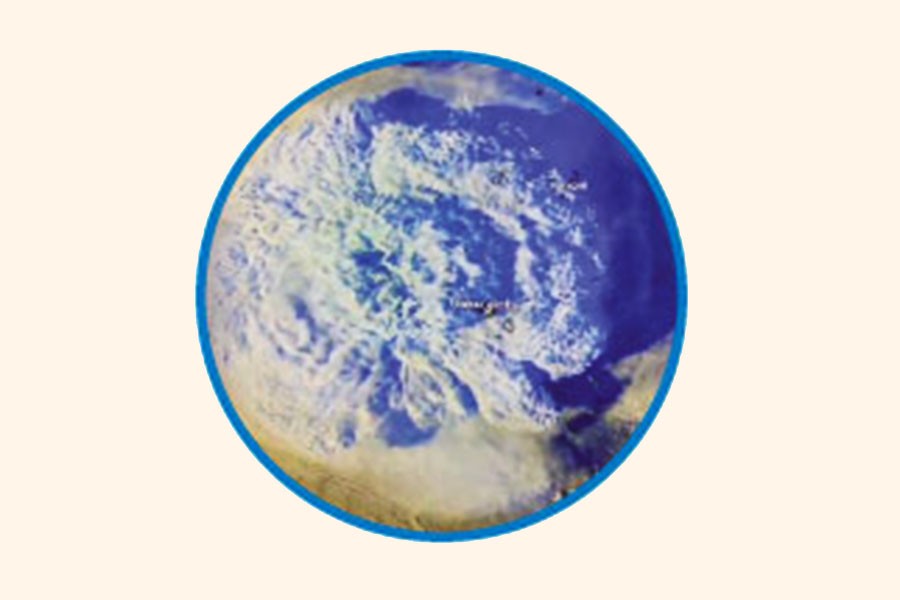
Published :
Updated :

On January 14, the world saw a huge geological event taking place at Hunga Tonga-HungaHa'apai, a volcanic island in the island kingdom of Tonga, an archipelago, in the South Pacific Ocean. It was the eruption of the volcano on which the said volcanic island was situated. The volcanic eruption reached its peak the next day on January 15. In consequence, the volcanic island of Hunga Tonga-HungaHa'apai was completely obliterated and the blast was so intense that its sound could be heard from faraway Alaska. How powerful was the eruption? According to NASA scientists the energy the explosion released was equivalent to that of a 10-megaton nuclear bomb. Compared to the bomb that destroyed Hiroshima of Japan in August 1945, the Tonga explosion was 500 times stronger. And the 15 metres high tsunami wave that the eruption generated reportedly drowned two beachgoers in Northern Peru more than 10,600 kilometres away in South America.
The Tonga eruption is reminiscent of a similar geological event of enormous scale that wiped out another island, Krakatoa, in the west of Java in Indonesia in 1883. It is said that the sound from the Krakatoa explosion travelled seven times around the globe and it was heard from 50 different locations around the world. A 1968 Hollywood film, 'Krakatoa, East of Java' (though the lost island was on the West of Java) tried to give a sense of how violent the geological event was. However, the film was not exactly about the volcanic eruption. It only provided the story of the film with a background, while the plot thickened surrounding the recovery of a cargo of pearls from a sunken ship, as the story goes, during the time of the Krakatoa eruption. Science was not so advanced in the late 19th century to graphically illustrate the event of Krakatoa as it is now possible in the case of Tonga eruption.
The Hunga Tonga-HungaHa'apai volcano, is located 40 miles north of the Tongan capital, Nuku'alofa. Its eruption spewed lava that rose as high as 30 kilometres in the sky. Considering the number of casualties, it cannot be said to be high, thanks to the sparsely populated islands that make Tonga. In fact, out of the 169 islands of the Tongan kingdom, 74 per cent of the population (of around 100,000) is concentrated on the main island of Tongatapu. Even so the lava from the volcanic eruption overcast the region with a thick cloud of ash and dirt and it was so thick that a pall of darkness fell over the capital of the country, Nuku'alofa, situated on Tongatapu. It has made it difficult for the relief coming from abroad to be delivered properly.
Since the volcanic event took place in a faraway place in the Pacific, the people in the rest of the world could know about the scale of it only from what the electronic media had dished out. But what would be the impact had the volcanic event happened near a densely populated area? We know of one that occurred 15 years ago in 2004 when a tsunami originating in the Indian Ocean killed around 165,000 people in the islands of Aceh and Nilas in Indonesia. However, geologists would like to assure us that the South Pacific where the Tonga eruption happened may not see another of its kind any time soon. In fact, NASA scientists had been observing the volcano that erupted between January 14 and 15 for years. The area where the Tongan islands lie is a subduction zone of the Earth's crust. Actually, one of the earth's tectonic plates has dipped beneath another. NASA scientists were not aware of when the formation of a volcano with a summit ringed by hills in that area took place. But between 2014 and 15, as a result of volcanic activity created a platform around the rim of the crater. The platform rose above the sea in the shape of a new island, Hunga Tonga-HungaHa'pai. Volcanic ash and other debris joined this new island with older ones on either side of it. What happened on January 14-15 was the complete destruction of the island by the volcanic eruption. According to NASA scientist, Dan Slayback, the blast was so massive that it took with it chunks of the older islands connected to Hunga Tonga-HungaHa'apa. James Gavin, NASA's chief scientist at its Goddard Space Flight Center told NPR about what might have taken place. It goes like this. The island's formation itself contained the seed of its destruction. For as it raised its head out of the sea, layers of magma filled a network of chambers beneath it. And the explosion was triggered, he believes, by a sudden change in the subterranean plumbing which caused seawater to flood in.
Today's science can pinpoint what goes behind such calamitous events as the one that destroyed a Tongan island. But back in 1970 when the southern coast of Bangladesh was devastated by what we know as a tidal bore, the people of this part of the world had no inkling of what lay behind the cataclysm. But according to conservative estimates a million of people died in that tidal event. Could a normal tidal surge be so devastating or was it a tsunami? Wild theories went around surrounding that tidal bore. Some even suspected that a secret nuclear explosion conducted undersea might have caused the event. Compared to those times, Tongans are luckier in that they know at least what caused the natural calamity that befell them.
sfalim.ds@gmail.com


 For all latest news, follow The Financial Express Google News channel.
For all latest news, follow The Financial Express Google News channel.